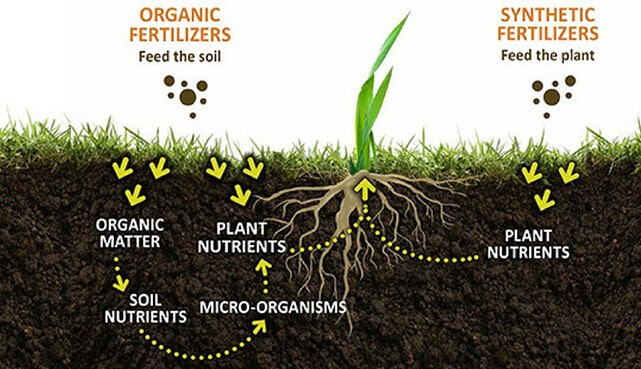
Organic fertilizers
They are compounds from animal or vegetable residues, which have a slower action compared to mineral fertilizers because their decomposition is more complex. These fertilizers may originate from animal manure (farms, farms, livestock, corrals, farms, etc.), waste from wineries, filter cakes from sugar and alcohol plants (vinasse), green manure and oil residues (from oil industries).
Fertilizer acidity / alkalinity classification: Fertilizers can influence the pH of the soil, making it more or less acidic, alkaline or neutral.
• ACIDS: Fertilizers with acid characteristics may contain ammonia phosphate, nitrate or sulfate in their composition, urea, dried blood or anhydrous ammonia.
• ALKALINES: Fertilizers with alkaline or basic characteristics may contain sodium nitrate, dolomitic limestone, lime, potassium nitrate, among others.
• NEUTRAL: Fertilizers that have no influence on soil pH are classified as neutral and may contain nitrocal, superphosphate and potassium chloride.
Organic fertilizers are fertilizers derived from animal matter, animal excreta (manure), human excreta, and vegetable matter (e.g. compost and crop residues). Naturally occurring organic fertilizers include animal wastes from meat processing, peat, manure, slurry, and guano.
In contrast, the majority of fertilizers used in commercial farming are extracted from minerals (e.g., phosphate rock) or produced industrially (e.g., ammonia). Organic agriculture, a system of farming, allows for certain fertilizers and amendments and disallows others; that is also distinct from this topic.
Other Agricultural Research Service (ARS) studies have found that algae used to capture nitrogen and phosphorus runoff from agricultural fields can not only prevent water contamination of these nutrients, but also can be used as an organic fertilizer. ARS scientists originally developed the “algal turf scrubber” to reduce nutrient runoff and increase quality of water flowing into streams, rivers, and lakes. They found that this nutrient-rich algae, once dried, can be applied to cucumber and corn seedlings and result in growth comparable to that seen using synthetic fertilizers.
Sewage sludge, also known as biosolids, is effuent that has been treated, blended, composted, and sometimes dried until deemed biologically safe. As a fertilzer it is most commonly used on non-agricultural crops such as in silviculture or in soil remediation. Use of biosolids in agricultural production is less common, and the National Organic Program of the USDA (NOP) has ruled that biosolids are not permitted in organic food production in the U.S.; while biologic in origin (vs mineral), sludge is unacceptable due to toxic metal accumulation, pharmaceuticals, hormones, and other factors.
With concerns about human borne pathogens coupled with a growing preference for flush toilets and centralized sewage treatment, biosolids have been replacing night soil (from human excreta), a traditional organic fertilizer that is minimally processed.
For direct import quotations: contact@rymaxglobal.com